Ever noticed your cat snoozing in the hottest room of the house? It might seem baffling, but there’s often a reason behind their choice of location that goes beyond mere comfort.
Cats are naturally drawn to warmth due to their evolution as hunters and their preference for cozy spots that mimic their instinctual behaviors.
But this decision may reveal more than just a love for heat, as your feline friend might have some secrets to share about their preferences and habits.

Why Cats Seek Warmth in the First Place
Cats have a natural instinct to prefer warm spots. Unlike people, their normal body temperature hovers around 101 to 102.5 degrees Fahrenheit, making them feel coziest in warm environments. This preference isn’t just about comfort; it also ties back to their evolutionary needs. In the wild, seeking warmth helps them conserve energy and stay protected from the elements.
Another reason your kitty might be drawn to the heat is their hunting instincts. A warm resting place can mean a cozy nook where they can feel secure and prepared for action at any moment. Furthermore, the warmth can help soothe sore muscles or provide a sense of relaxation they crave after a long day of playing or exploring.
It’s also worth noting that cats love the thermal qualities of different materials. You might notice them snuggling in a sunbeam, on a cozy blanket, or even next to electronics that emit heat. These behaviors not only provide physical warmth but also a sense of well-being and comfort. So, if your cat’s chosen napping spot feels like a sauna, it’s simply following its instincts to stay warm and cozy.
Do Cats Prefer Certain Rooms?
Absolutely, some rooms can seem like a feline paradise compared to others! Your cat likely gravitates toward rooms that retain heat better or have sunny spots. For example, areas with large windows or facing south often collect more sunlight, which is an attractive feature for many cats looking to soak up those rays.
Here’s a handy list of factors that can make specific rooms more appealing to your furry friend:
- Windows: Cats adore viewing outside life; a room with a window provides warmth and entertainment.
- Bedding: Rooms with soft, warm bedding invite some serious relaxation time for your cat.
- Electronics: Rooms with TVs or computers can be warmer due to heat emissions, making them a comfy spot.
- Hiding Spaces: Cats feel safer in places with cozy hiding spots, like behind furniture or inside closets.
- Static Warmth: Rooms with carpets or radiators are often warmer and can feel particularly inviting.
Offering your cat accessible places to enjoy warmth can make your home even more welcoming for them. Consider setting up a sun spot or a cozy cat bed where it can relax and feel safe. It’s all about creating a comfortable environment that caters to their natural preferences! For more insights into cat behavior, check out the American Society for the Prevention of Cruelty to Animals (ASPCA) here.
How Do Cats Regulate Their Body Temperature?
Cats have an impressive ability to regulate their body temperature, which hovers around 101 to 102.5 degrees Fahrenheit. Unlike humans, they’re not just sweating it out in the heat. Instead, they rely on a mix of behavioral and physiological strategies.
One major way they cool down is through panting and seeking shade in warmer conditions. You’ll often see them stretching out in the sun when it’s chilly, while they’ll gravitate toward cooler spots during hot spells. On the flip side, cats love warmth because their bodies function better at higher temperatures; it’s like taking a cozy bath for them. Sleeping in a hot room might be their way of soaking up that warmth, especially if they’ve been outdoors.
Interestingly, posture plays a role too—cats curl up to conserve heat in cooler environments. In hot conditions, they’ll spread out and lean against surfaces, maximizing their body contact with warm spots. This unique approach to temperature regulation might have your kitty lounging in the balmy rooms of your home more often than you’d expect.
Does Room Temperature Affect a Cat’s Sleep Quality?
Warm room temperatures can significantly affect a cat’s sleep quality. Cats are instinctively driven to choose spots that enhance their comfort. If they select the hottest room, there’s a good chance they’re finding a cozy nook that promotes relaxation and rejuvenation.
Consider how temperature influences sleep cycles:
- Temperature and Sleep Depth: Warmer environments can encourage deeper sleep, which is crucial for a cat’s overall health.
- Metabolic Function: A warm room can foster better metabolic function while they rest, ensuring they recharge adequately.
- Safety and Comfort: Cats perceive warmer places as safe havens. A hot room might feel more secure and protective, mimicking the sunbathing habits they’d engage in outside.
Here’s a little insight: while cats do gravitate toward warmth, it’s important to ensure they don’t overheat. Regularly check how they’re doing in hot rooms, and provide cool spots if needed. Cats can’t vocalize discomfort like humans, so observant pet parents should keep an eye on signs like excessive panting or restlessness.
For more detailed insights, check out the American Association of Feline Practitioners’ guidelines on cat health: aafp.org.
Remember, maintaining an optimal environment contributes to your cat’s sleep quality and helps sustain their health.
What Are the Benefits of Sleeping in Warm Areas?
Cats have a unique affinity for warmth, and there are several reasons they gravitate towards the hottest rooms in your home. Body temperature regulation plays a significant role. Cats maintain a body temperature of around 101 to 102.5 degrees Fahrenheit. When they sleep in warmer areas, it helps conserve their energy by reducing the effort needed to stay warm. This is especially beneficial for older cats or those with health issues, as they may struggle to regulate their temperature efficiently.
The comfort factor can’t be ignored either. Warm spaces can create a cozy atmosphere that makes your feline feel safe and secure. It recreates the natural warmth they’d find in sunlit spots outdoors. Plus, the heat can soothe stiffness in their muscles and joints, which is essential for overall comfort and relaxation. Interestingly, some studies suggest that sleeping in warmer areas may even help them feel more secure, tapping into their instinct to seek shelter and safety.
Are There Risks to Sleeping in the Hottest Room?
While the sun-soaked nook can seem like a perfect cat haven, there are potential dangers to consider. Excessive heat can lead to dehydration or heat stroke, especially if the room doesn’t have proper ventilation. Cats can’t sweat like humans; they primarily cool themselves by panting or through their paw pads. If the environment is too hot, those methods might not be enough.
Here are some risks to keep in mind:
- Heat Exhaustion: Cats can suffer from heat exhaustion or heat stroke if temperatures exceed their comfort range.
- Dehydration: Without easy access to fresh water, a cat can easily become dehydrated in a hot room.
- Respiratory Distress: High temperatures can exacerbate respiratory issues, particularly in elderly or sick felines.
It’s crucial to monitor your cat’s access to cool areas, especially on scorching days. Always ensure there’s fresh water available and consider using fans or air conditioning to keep the environment livable. For more on cat heat exposure, you can check resources from the ASPCA here.
Having a comfy retreat where they can cool off is just as important as those warm spots!
How Can You Create a Comfortable Space for Your Cat?
Cats are experts at finding the warmest spots in your home, and if they’re gravitating toward the hottest room, it’s essential to consider their comfort. Here’s how to create a cozy oasis for your feline friend that harmonizes with their natural behaviors:
-
Allocate a Sunny Spot : Place a soft bed or blanket in a sunny corner. Cats love basking in warmth, so an area with sunlight streaming in will be inviting.
-
Choose Soft Textiles : Use plush blankets or cushions. Cats often prefer surfaces that feel good against their fur, so incorporating a variety of materials can help.
-
Utilize Heating Pads : A heating pad set to low can be a great addition, specifically if your cat enjoys a warm spot but also needs some gentle warmth during cooler months.
-
Minimize Drafts : If your hottest room has drafts, add curtains or drapes to help maintain a cozy temperature. Cats hate being cold!
-
Create Vertical Spaces : Cat trees or shelves can provide warmth from higher spots, where heat tends to rise, along with perfect lounging areas.
-
Keep Their Favorite Toys Nearby : A few of their beloved toys in this cozy area will make the space feel even more secure and inviting.
-
Consider Cat Furniture : Opt for cat furniture designed to reflect warmth, such as those made with thermal materials. This adds another layer of comfort.
By tailoring these spaces to reflect your cat’s likes, you’re ensuring they have a refuge that meets their need for warmth and comfort.
Fun Facts About Cats and Temperature Preferences
Cats have some fascinating quirks when it comes to temperature. Here’s a list of intriguing insights you might not know:
-
Body Temperature : A cat’s average body temperature is around 100°F to 102.5°F. This means they naturally seek warm environments that echo their own body heat.
-
Survival Instincts : In the wild, being near warmth is synonymous with safety. Predators tend to be less active in hotter environments, making warm spots a strategic choice for a cat’s native instincts.
-
Seasonal Changes : Cats may seek out warmer places during winter, while in the summer, they adapt to cooler spots. Monitor your cat’s behaviors as the seasons change!
-
Purring and Warmth : Cats often purr when they’re snug and warm. This habit not only signifies contentment but may also act as self-soothing heat generation.
-
Sleeping Habits : Cats sleep for an average of 12-16 hours a day, and when they’re snoozing in the hottest room, it’s likely because they’ve found their ultimate snooze zone.
Understanding these peculiarities can change how you perceive your cat’s behaviors around temperature. For more insights on feline care, check out The Spruce Pets for reliable information.
What Should You Do if Your Cat Sleeps in a Dangerous Spot?
Cats have an uncanny ability to find the coziest yet most perilous napping spots. If you’ve noticed your feline friend curling up in an area that could pose a risk—like near a heater, on top of a precarious stack of pillows, or even in a tightly enclosed space—it’s crucial to redirect them to safer alternatives without causing stress.
-
Provide Alternatives : Create inviting sleeping areas using soft blankets or pet beds in safer spots. Cats love enclosed spaces, so consider a plush cat cave or a box.
-
Temperature Control : If your cat seeks warmth, try adjusting the temperature in your home. Use fans or air conditioning to cool down hot rooms or block direct sunlight in certain areas during the hottest part of the day.
-
Distraction Techniques : If they seem intent on returning to a dangerous spot, gently but firmly guide them to their designated safe areas. Use treats or toys to make the new spot more appealing.
-
Monitor Behavior : Keep an eye on your cat’s habits. If they consistently choose risky spots despite your efforts, consult your vet to rule out any underlying issues that might be affecting their behavior.
-
Use Deterrents : If necessary, use safety measures like barriers or deterrent mats in areas where they shouldn’t go.
Being proactive is key in ensuring your cat’s safety while still allowing them to enjoy their cozy nap time.
The Connection Between Heat and Cat Behavior
Cats are natural sun-seekers, often gravitating toward the warmest room in the house. This behavior is deeply rooted in their instincts and physical makeup. Cats have a higher body temperature than humans, averaging around 101.5°F to 102.5°F, which makes them crave warmth, especially during colder months.
The benefits of warmth go beyond comfort for your kitty. Heat plays a significant role in:
-
Energy Conservation : Cats often choose warmer spots to save energy. This is particularly true for older cats or those recovering from illness.
-
Muscle Relaxation : Heat helps to soothe muscles and joints, making naptime more appealing, especially for cats with arthritis or other mobility issues.
-
Comfort and Security : A warm environment can provide a sense of safety. Cats instinctively seek out places that feel secure, often correlating to warmer locations that remind them of their instinctual safe zones.
Understanding this connection can help cat owners create an environment that caters to their pet’s needs without compromising safety or health. For more detailed insights on cat behavior, you can check out resources from the American Association of Feline Practitioners here.
Alex, a passionate animal lover, has experience in training and understanding animal behavior. As a proud pet parent to two dogs and three cats, he founded AnimalReport.net to share insights from animal experts and expand his knowledge of the animal kingdom.




